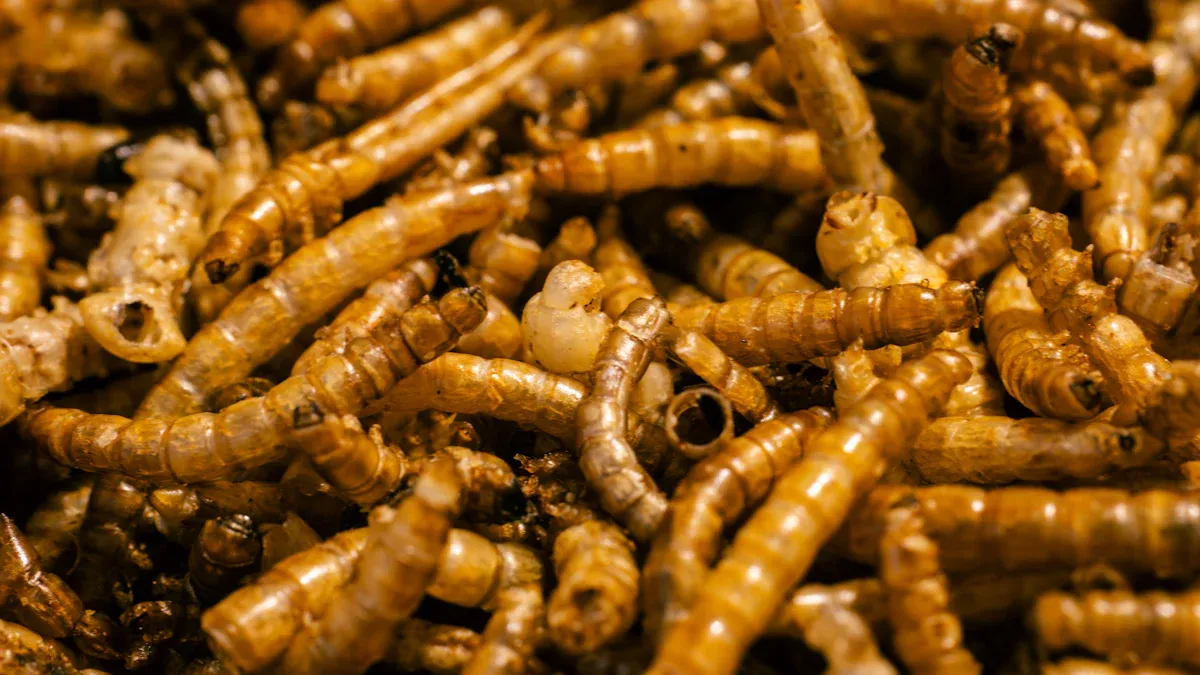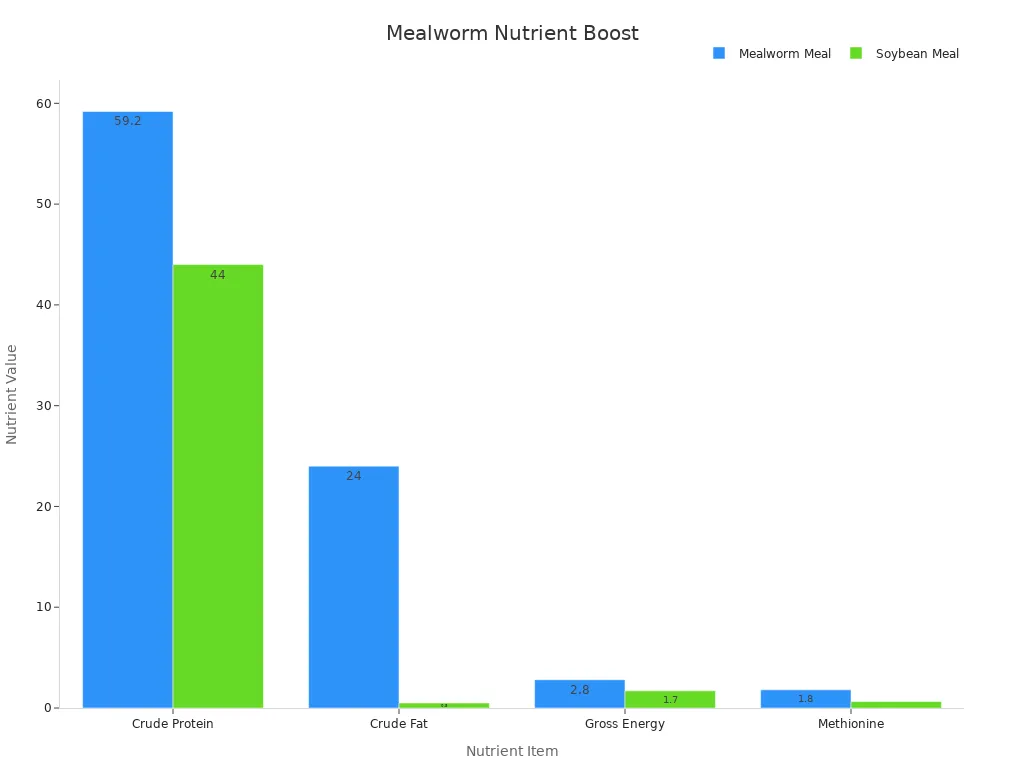
African poultry farmers often face steep feed costs and limited access to quality options. For example, Egypt imports about 75% of its feed and raw materials, showing a heavy reliance on imports. With poultry production making up just 6.3% of global chicken meat output, farmers struggle to meet local demand. Dried mealworms 1 Lb offers a practical, nutrient-packed solution. These high-protein insects can improve poultry health, boost productivity, and make farming more profitable.
Key Takeaways
- Dried mealworms are a protein-rich feed option with 50-55% protein. They help chickens grow faster and stay healthier.
- Adding dried mealworms can boost egg production and meat quality. This means bigger eggs and tastier meat, which sell for more money.
- Using dried mealworms lowers feed costs and improves feed efficiency. This saves money over time and supports eco-friendly farming.
Nutritional Benefits of Dried Mealworms
High Protein Content for Poultry Growth
Protein is the building block of life, and for poultry, it plays a vital role in growth and development. Dried mealworms are a powerhouse of protein, containing 50-55% crude protein by weight. This makes them an excellent alternative to traditional protein sources like soybean meal or fishmeal.
To put this into perspective, here’s a comparison of nutritional components between mealworms and black soldier fly larvae:
| Nutritional Component | Mealworms | Black Soldier Fly Larvae |
|---|---|---|
| Crude Protein | 50-55% | 32-42% |
| Fat Content | 25-30% | N/A |
| Amino Acid Profile | Balanced | Balanced |
| Health Benefits | Immunostimulant, gut health | Antimicrobial properties, gut health |
Farmers who incorporate dried mealworms into their poultry feed often notice faster growth rates and healthier birds. A study by Bovera et al. (2016) even highlighted improved feed conversion ratios in chickens fed insect-based diets. This means birds grow more efficiently, saving farmers money on feed costs.
Essential Nutrients for Healthier Birds
Dried mealworms are more than just a protein source. They are packed with essential nutrients that contribute to overall bird health. These include fatty acids for energy, vitamins for immunity, and chitin, a natural compound that supports gut health.
Research shows that dried mealworms contain approximately 50% protein by dry weight, which is crucial for muscle development. The fatty acids they provide help maintain energy levels, ensuring birds stay active and healthy. Additionally, chitin acts as a prebiotic, promoting a balanced gut microbiome. Healthier birds are less prone to diseases, reducing the need for antibiotics and lowering veterinary costs.
Boosting Egg Production and Meat Quality
Farmers looking to improve egg production and meat quality will find dried mealworms to be a game-changer. These insects are rich in nutrients like methionine, an essential amino acid that supports egg-laying and enhances meat texture. Compared to soybean meal, dried mealworms offer higher levels of crude protein, fat, and energy, making them a superior feed option.
| Nutritional Item | Mealworm Meal | Soybean Meal |
|---|---|---|
| Crude Protein (g) | 59.2 | 44 |
| Crude Fat (g) | 24 | 0.5 |
| Gross Energy (MJ) | 2.8 | 1.7 |
| Methionine (g) | 1.80 | 0.65 |

Farmers who supplement their poultry feed with dried mealworms often report larger eggs, richer yolks, and better-tasting meat. These benefits not only improve the quality of the final product but also increase its market value, boosting profitability for farmers.
Economic Advantages of Dried Mealworms 1 Lb
Cost-Effectiveness Compared to Traditional Feeds
Feed costs often take up a significant portion of a poultry farmer’s budget. Traditional feeds like soybean meal are not only expensive but also subject to price fluctuations due to global supply chain issues. Dried Mealworms 1 Lb offers a more stable and potentially cost-effective alternative. These nutrient-rich insects can be produced locally, reducing dependency on imported feed ingredients.
To better understand the economic advantages, here’s a comparison between dried mealworms and traditional feeds like soy:
| Aspect | Dried Mealworms | Traditional Feeds (Soy) |
|---|---|---|
| Economic Advantages | Potentially lower costs | Higher production costs |
Farmers who switch to dried mealworms often notice a reduction in overall feed expenses. By sourcing mealworms locally, they can bypass the high costs associated with imported feeds. This makes dried mealworms an attractive option for farmers looking to cut costs without compromising on quality.
Improved Feed Conversion Rates
Feed conversion rate (FCR) measures how efficiently animals convert feed into body weight. A lower FCR means better efficiency, which translates to cost savings for farmers. Dried mealworms have been shown to improve FCR in poultry due to their high protein content and balanced amino acid profile. Birds digest mealworms more easily, allowing them to gain weight faster while consuming less feed.
For example, studies have shown that chickens fed with insect-based diets, including dried mealworms, achieve better growth rates compared to those on traditional feeds. This efficiency not only reduces feed consumption but also shortens the time needed to raise birds to market weight. Farmers benefit from quicker turnover and reduced feeding costs.
Long-Term Savings for Farmers
Switching to dried mealworms isn’t just about immediate cost savings—it’s a long-term investment in sustainable farming. By improving poultry health and productivity, dried mealworms help farmers reduce expenses on veterinary care and supplements. Healthier birds are less prone to diseases, which means fewer losses and higher profits over time.
Additionally, the local production of dried mealworms creates opportunities for farmers to collaborate with insect farming industries. This not only supports the local economy but also ensures a steady supply of affordable feed. Over time, these factors contribute to significant savings and a more sustainable farming model.
Farmers who adopt dried mealworms as a primary feed ingredient often find themselves better equipped to handle market challenges. With lower feed costs, improved efficiency, and healthier birds, they can achieve greater profitability and long-term success.
Sustainability and Environmental Impact
Eco-Friendly Farming Practices
Dried mealworms offer farmers a chance to embrace eco-friendly practices. These insects require far less land and water compared to traditional protein sources like soy or fishmeal. Farmers in Algeria have shared how switching to mealworms has made them feel proud of their sustainable choices. By using mealworms, they reduce the strain on natural resources while improving their farming operations.
Mealworms also align with global sustainability goals. Their production generates fewer greenhouse gas emissions and uses less energy than raising livestock. This makes them a smart choice for farmers who want to protect the environment while boosting their poultry’s health.
Reducing Poultry Farming’s Carbon Footprint
Switching to dried mealworms can significantly lower the carbon footprint of poultry farming. Compared to traditional protein sources, mealworms produce fewer greenhouse gases and require less land. Here’s a comparison of sustainability metrics:
| Metric | Mealworms | Milk | Chicken | Pork | Beef |
|---|---|---|---|---|---|
| Land Use (per kg protein) | 43% | 100% | 46-88% | 55-137% | 102-158% |
| Greenhouse Gas Emissions | Low | 1.77-2.80x | 1.32-2.67x | 1.51-3.87x | 5.52-12.51x |
| Energy Use | Higher | 21-83% | 46-88% | Similar to pork | Lower than beef |
Farmers who adopt mealworms contribute to a cleaner environment. They reduce emissions and conserve resources, making poultry farming more sustainable for future generations.
Supporting Local Insect Farming Industries
Using dried mealworms doesn’t just benefit the environment—it also supports local economies. Farmers can collaborate with insect farming industries to source mealworms locally. This creates jobs and strengthens communities.
Insect farming is a growing industry in Africa, and mealworms are at the heart of this movement. By choosing mealworms, farmers help build a sustainable supply chain that benefits everyone involved. This partnership ensures a steady supply of affordable feed while promoting eco-friendly farming practices.
Practical Tips for Using Dried Mealworms
Gradual Introduction into Poultry Feed
Switching to dried mealworms should be done gradually to help poultry adjust to the new feed. Sudden changes in diet can sometimes upset digestion. Farmers can start by mixing a small amount of dried mealworms into the existing feed. Over a week or two, they can slowly increase the proportion of mealworms while reducing the old feed.
Tip: Begin with a 10% inclusion rate and monitor the birds’ response. If they adapt well, increase the percentage gradually.
Observing the birds during this transition is crucial. Healthy behavior, consistent appetite, and normal droppings indicate a smooth adjustment. This step-by-step approach ensures the birds benefit from the nutrients without any stress.
Recommended Feeding Ratios
Getting the right feeding ratio is key to maximizing the benefits of dried mealworms. For optimal results, farmers can follow these general guidelines:
- Chicks (0-6 weeks): Add 5-10% dried mealworms to their feed.
- Growing Birds (6-20 weeks): Increase to 10-15%.
- Laying Hens: Use 15-20% to support egg production.
Note: These ratios may vary depending on the bird species and specific nutritional needs. Consulting a poultry nutritionist can help fine-tune the diet.
Finding Trusted Suppliers for Dried Mealworms 1 Lb
Sourcing high-quality dried mealworms is essential for success. Farmers should look for suppliers who prioritize quality and sustainability. Trusted suppliers often provide detailed product information, including protein content and production methods.
Here are some tips for finding reliable suppliers:
- Check online reviews and testimonials.
- Verify certifications or quality standards.
- Compare prices to ensure affordability without compromising quality.
Partnering with a reputable supplier ensures farmers get the best value and consistent results for their poultry.
Dried mealworms offer African farmers a sustainable way to boost poultry productivity. These insects enhance growth, improve meat quality, and support eco-friendly farming. Research confirms their transformative impact on poultry diets. Farmers can explore trusted suppliers of Dried Mealworms 1 Lb to unlock long-term savings and healthier, more productive flocks.
FAQ
What makes dried mealworms better than traditional poultry feed?
Dried mealworms provide higher protein, essential nutrients, and better digestibility. They improve poultry growth, egg production, and meat quality while being eco-friendly and cost-effective.
How can farmers store dried mealworms properly?
Farmers should store dried mealworms in airtight containers in a cool, dry place. This prevents moisture and keeps the feed fresh for longer.
Are dried mealworms safe for all types of poultry?
Yes, dried mealworms are safe for chickens, ducks, and other poultry. They offer balanced nutrition and support healthy growth across various bird species.

